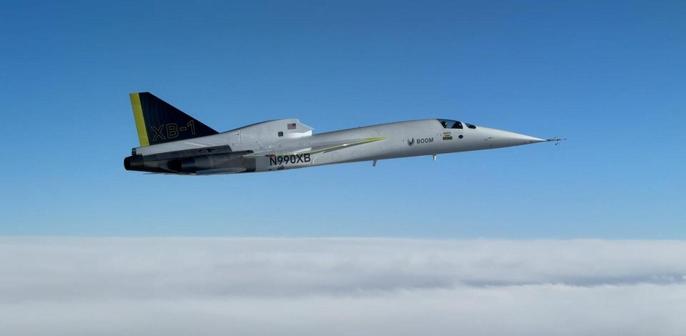Recent searches
Search options
#supersonic
#Supersonic #planes are inching toward takeoff. That could be a problem.
Boom estimates that one of its full-sized Overture jets will burn two to three times as much fuel per passenger as a subsonic plane’s first-class cabin. Compared to standard economy-class travel, first-class cabins tend to have larger seats with more space between them. Because there are fewer seats, more fuel is required per passenger, and therefore more #emissions are produced for each person.
https://www.technologyreview.com/2025/02/05/1111002/supersonic-planes-climate/
‘Even the F-22, developed almost 50 years after the Concorde and the reigning undisputed air supremacy fighter can only supercruise at Mach 1.8 and its top speed – Mach 2.2 – is the same as for a Tornado. If Concorde was still flying, it is unlikely it would be able to photograph it at Mach 2.0. Even if the Soviets back at the time were willing to lend the Mig-25/Mig-31, it is not entirely clear if it would be able to sustain the level flight with Concorde at Mach 2.0 for long enough to have a picture taken.’
Extreme supersonic winds measured on a planet outside our solar system
https://phys.org/news/2025-01-extreme-supersonic-planet-solar.html
An Exoplanet’s Supersonic Jet Stream
WASP-127b is a hot Jupiter-type exoplanet located about 520 light-years from us. A new study of the planet’s atmosphere reveals a supersonic jet stream whipping around its equatorial region at 9 kilometers per second. For comparison, our Solar System’s fastest winds, on Neptune, are a comparatively paltry 0.5 kilometers per second. The team estimates the speed of sound — which depends on temperature and the atmosphere’s chemical make-up — on WASP-127b as about 3 kilometers per second, far below the measured wind speed. The planet’s poles, in contrast, are much colder and have far lower wind speeds.
Of course, these measurements can only give us a snapshot of what the exoplanet’s atmosphere is like; we don’t have altitude data, for example, to see how the wind speed varies with height. Nevertheless, it shows that exoplanets beyond our planetary system can have some unimaginably wild weather. (Video and image credit: ESO/L. Calçada; research credit: L. Nortmann et al.; via Gizmodo)
"Boomless Cruise: How Boom Supersonic’s XB-1 breaks the sound barrier quietly" by AeroTime - #XB1 test flight had sensors monitoring on the ground which confirmed no sonic boom reached the ground during three times it exceeded Mach 1. Using subsonic speed longer for climb, they reached Mach 1+ above the altitude where booms refract back up before reaching the ground. A nice new trick for potential #supersonic air #travel over land. https://www.aerotime.aero/articles/boom-supersonic-boomless-cruise #aviation #avgeek
Hackaday Links: February 2, 2025 - All things considered, it was a very bad week for aviation here in the United Stat... - https://hackaday.com/2025/02/02/hackaday-links-february-2-2025/ #hackadaycolumns #hackadaylinks #wavefunction #robotserver #ipbullying #kidnapping #supermario #supersonic #testflight #abduction #asteroid #electron #nintendo #orbitals #roadster #quantum #slider #tesla #boom #xb-1
This is almost certainly the last stage ever of fromis_9. No wonder members of the audience and of the group are in tears. I will miss them!
Nevertheless, this was a good stage on which to end. Even though "Supersonic" is not my favourite of their title tracks - I prefer "Feel Good" -- it's still a good song. I also liked their styling; the choice of elegant boots and heels, as opposed to the chunky and clunky, was inspired.
#Kpop #Fromis9 #Supersonic #KpopStyling #GirlGroups
https://youtu.be/N7mZmPxiB00?
si=TzUg8vCQRVTnjTGn
Today brought quite a leap forward for #BoomSupersonic: Its XB-1 demonstrator aircraft became the first civilian jet plane to fly faster than sound in 22 years. https://cosmiclog.com/2025/01/28/boom-goes-supersonic-with-xb-1-jets-flight-test/ #Boom #Supersonic #Tech #Aerospace #Aviation #Avgeek
@hkrn
Err, do you mean the THIRD civil aircraft to 'go supersonic'?!
#idiots #Concorde #TU144 #aircraft #flight #supersonic
https://en.wikipedia.org/wiki/Concorde
#Boom’s XB-1 becomes first civil aircraft to go #supersonic - https://techcrunch.com/2025/01/28/booms-xb-1-becomes-first-civil-aircraft-to-go-supersonic/ last time I checked, #Concorde was not a military aircraft...
Air France Concorde F-BVFA at the on display at the National Air and Space Museum's Steven F. Udvar-Hazy Center in Chantilly, Virginia #Smithsonian #AirFrance #Concord #Supersonic #aviationphotography #AvGeek #photography #Nikon #aircraft #nikonphotography
NASA’s X-59 Quiet Supersonic Jet Reaches a Major Milestone
https://scitechdaily.com/nasas-x-59-quiet-supersonic-jet-reaches-a-major-milestone/
#NASA #NASAquest #aviation #supersonic
'The Death Trap' Dangerous Jet #CombatTraining Dramatically Increases Over #TohonoOodham Nation
By #BrendaNorrell, #CensoredNews, Oct. 17, 2024
SELLS, Arizona -- "The #USMilitary has dramatically increased its dangerous jet combat fighting over the heart of the Tohono O'odham Nation, with combat jets, a private #corporation and a plane labeled as "the death trap," due to safety violations.
"Tohono O'odham who live below say the #SonicBlasts are breaking the plaster in their traditional homes. Dangerous flares endanger all life below, including the #EndangeredSpecies of #SonoranPronghorn and more. With the risk of deadly crashes, Tohono O'odham are at risk below, including those in the community of #Pisinemo this week.
"The U.S. Air Force now plans to expand its dangerous use of the #airspace over Tohono O'odham, #Apache and #Yaqui communities in #Arizona. #SacredPlaces including #BaboquivariPeak on the Tohono O'odham Nation are among those at risk.
"The enormous #Goldwater#ange -- 1.9 million acres in the #SonoranDesert west of the Tohono O'odham Nation -- was set aside for U.S. military training, yet the military is consistently using Tohono O'odham Nation airspace.
The #USAirForce wants to authorize more #supersonic blasts training at lower altitudes. The dangerous expansion includes airspace over #NativeAmericanNations, and scenic regions of Arizona and western #NewMexico."
Read more:
https://bsnorrell.blogspot.com/2024/10/the-death-trap-dangerous-jet-combat.html
Efficiency gains from engines will still be vital for the industry.
The most marked change in the appearance of #engines could be the return of the open #propeller.
The design dispenses with the #nacelle
– the cover
– to allow for a bigger fan that offers more propulsive force.
Superficially, it will look like existing turboprop engines,
but with the ability to fly at Mach 0.8, or 80% of the speed of sound
– the same as current jet engines.
#CFM, a joint-venture between America’s General Electric and France’s Safran, has said that its open fan #Rise engine could theoretically reduce fuel consumption and carbon emissions by 20%.
The company says it can reduce noise, which put paid to a previous prototype in 1986.
It will still have to persuade regulators and passengers that the engines will be safe if a blade breaks in midair.
As well as radical changes to airframes or engines, manufacturers are constantly looking for ways to salami-slice #fuel burn via small gains.
#Winglets, the curved tips of wings, were first introduced in the 1970s in response to the then oil crisis,
mimicking birds’ wings to reduce drag.
The split winglets on the 737 family since 2014 can reduce fuel burn by as much as 2% during a long journey, according to the Seattle-based manufacturer Aviation Partners.
(For plane-spotters, they double as the easiest way to distinguish a 737 from an A320.)
Birds have had millennia to evolve the ideal features for efficient flight,
so aviation designers have constantly used them for inspiration.
Airbus is experimenting with #gust #sensors on the front of the aircraft to register during turbulence,
with automatic responses from control surfaces of the wing,
similar to a bird’s constant adjustments to movements in the air.
#Concorde, which flew on only a limited number of routes, was the last passenger plane in service with a truly distinctive design.
The supersonic jet, which had swept-back, delta wings, was retired in 2003.
#Boom #Supersonic, a startup, is testing the technologies for a proposed “son of Concorde” with a similar look.
That plane would only ever be a niche service, flying 80 passengers at a time on premium routes.
But there is a possibility that Boeing and Airbus take radically different approaches to the workhorses that carry billions of passengers each year.
If the manufacturers go in different directions, then passengers might start paying serious attention to plane design, says Addison Schonland, an analyst who tracks the industry at AirInsight.
“I don’t think we’ve ever had a situation before, to look at an aeroplane and say, ‘that’s completely different’,” he says.
“How will people react to seeing those novel shapes?”
(3/3)
#Airbus #JetZero #Delft #University #McKinsey #fuel #efficiency #Boeing #truss #transonic
Great talk from Boom CEO about the future of supersonic flight and what it’s gonna look like.
Awesome they’re just down the road
Listening to the Freak Zone on the 6 Music and the organiser of the festival is saying they'll probably have to find a new city to host them as Birmingham City Council has gone bankrupt.
This has had a knock on effect on the availability of local music venues and also property developers have taken away many of the spaces they have used.
After the Concorde, a long road back to supersonic air travel - Enlarge / NASA's and Lockheed Martin's X-59 experimental supersonic jet... - https://arstechnica.com/?p=2012990 #supersonicflight #supersonicboom #supersonic #features #science #nasa



